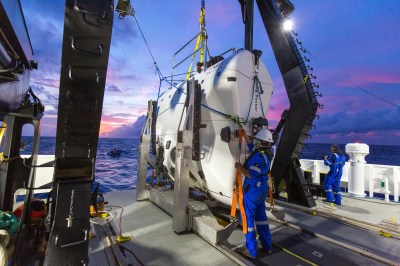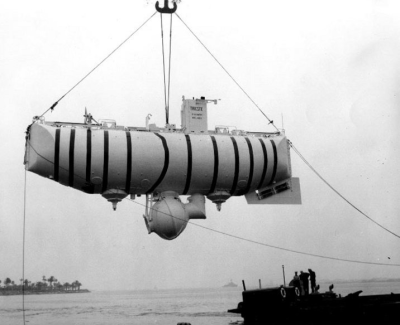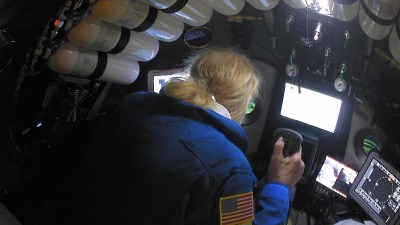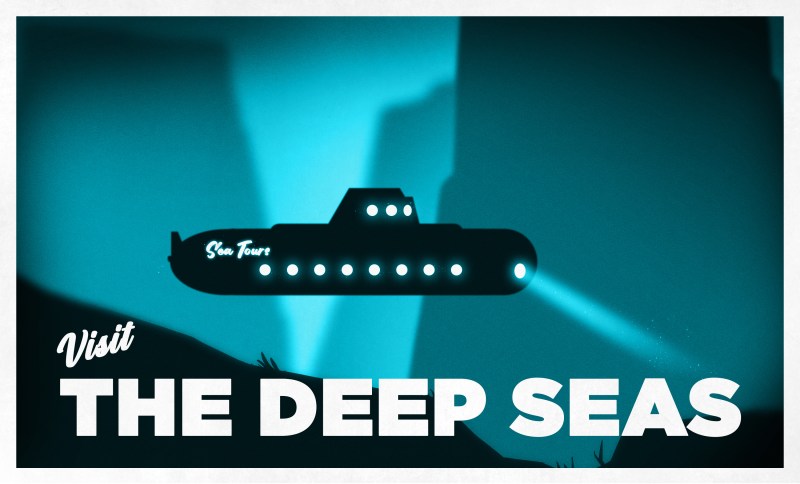Space may be the final frontier, but there are still Earthly frontiers that a select few have visited — the deepest depths of the high seas. Victor Vescovo, a Texas businessman and former Naval officer, is one of those few. Last spring, Vescovo realized his dream of becoming the first person to scrape the bottoms of all five oceans.
Vescovo descended alone in Limiting Factor, a $37 million two-seater submersible he commissioned from Triton, a private manufacturer who made this feat of engineering come to life. Vescovo and the crew discovered over 40 new species of aquatic lifeforms throughout the course of their Five Deeps expedition. But the attention-getting takeaway came when Vescovo visited the absolute lowest point on Earth. In the Challenger Deep portion of the Marianas Trench, seven miles below sea level, he saw a plastic bag drift by in the abyss.
One normal-sounding quirk sets this sub apart from others: it’s made to be reusable. You read that right, most super-deep divers never manage to dive over and over again.

A Super Submersible
Limiting Factor wasn’t built simply to satisfy the whims of a curious zillionaire. Its engineering pedigree makes the sub a top notch tool for repeatable deep sea exploration. In fact, Triton are already working on a research expedition vessel based on the new technologies explored and lessons learned from designing this special sub.
Limiting Factor is officially the first submersible to reach the deepest points of all five oceans. In order to accomplish this, it was built to withstand 20% more pressure than it would actually encounter anywhere on Earth. Much of the sub’s crush-proof factor comes from her grade 5 titanium hull, which was put through its paces at the Krylov Research Center in St. Petersburg, Russia.
The sub is powered by LiFePO4 batteries and equipped with a total of ten thrusters that allow movement in any direction, although it’s primarily designed to move vertically through the water with ease.

One-Shot Wonders
Although this record-setting submersible is not the first to scrape the Challenger Deep, it’s the first one that’s been built to do it an unlimited number of times.
The first manned sub to travel 11,000 meters to the Challenger Deep was Trieste, a bathyscaphe that made the trip in 1960. Trieste’s hull was built to withstand more than enough pressure, but one of the windows cracked on the dive down. Trieste was modified a few years later to search for a missing submarine, and is now retired and living in a museum.
In 2012, film director James Cameron piloted an Australian-built sub called Deepsea Challenger to the same place, recording a depth of 10,908 meters. Deepsea Challenger may have been able to make subsequent dives, but the world may never know. It was donated for research study and then damaged when the truck transporting it caught on fire.

And So Can You
With the Five Deeps expedition now complete, Vescovo has opened a few slots for pleasure dives to the Challenger Deep. For the low price of $750,000, you can go see the world’s most remote plastic bag for yourself.
This is not a trip for the claustrophobic or the faint of heart. It takes about four hours to ascend and descend, and there is only 16 hours’ four days’ worth of oxygen in the main system. Oh, and the entire vessel is about the size of a small SUV, so it’s just gonna be you and Vescovo in a small, dimly-lit cockpit, breathing recycled and CO₂-scrubbed air. If you can’t afford the trip, you’re in luck — a Five Deeps documentary is forthcoming.
Vescovo seems like a cool guy — all curiosity and possibility, nothing villainous about him in the slightest. Prior to the whole 20,000 leagues under the sea thing, he scaled all the world’s highest peaks. Here’s an interview that includes a decent amount of footage from the Marianas Trench, aka plastic bag-ville, beginning with the moment he lands and kicks up a four-foot cloud of virgin ocean floor.
















it’s also true for someone’s own country, many go around the world like crazy and still they only visited
their land maybe by 10-20 percent, not to mention with tourism they cause disturbance to other people
also not to mention the cultural differences and the infection carrying possibilities
There is a difference between undocumented and studied by humans and this one individual hasn’t been everywhere. If I want to learn about anywhere on the surface of the world huge amounts of data can be had for a few clicks. I don’t need to go there to learn something new about the ecology of New York State for example. In that case can probably if you really wanted to learn enough to have basically lived there. There is still much to learn about various parts of the world, and cultures are hard to really learn about second or thirdhand so there is some reason to travel for the curious.
AND CURIOSITY IS GOOD! Needs tempering with some common sense and wisdom but we move on a species by people thinking I wonder what…
This deep dives are something else from just one individuals doing in person however there is so much more to learn about the deep ocean. We know and care far less about the oceans in general than we should and the very bottom ocean trenches are pretty damn alien and just as hard to study with detail as another planet.
Oceans cover three quarters of our planet, yet we have explored only five percent of them. I kindly suggest you remove your head from your rear end.
Serendipity. I’m currently playing Subnautica.
Great story….seems like a nice guy.
Sorta reminds me of Hank Scorpio
https://www.youtube.com/watch?v=8Ew78KThLOY
“…on your way out, if you want to kill somebody, it would help me a lot.”
I appreciate that this particular zillionaire Stood Far Back When The Gravitas Was Handed Out.
Awesome. I totally get the reference, of course. Thanks – Victor V.
HI there! Actually, the submarine has 4 days (!) of total oxygen supply – not 16 hours. A safety requirement from certifying agency DNV-GL of Germany.
But thank you for the kind article. I very much appreciate you saying there is “nothing villainous about him in the slightest.” I certainly hope not.
I remind someone of Hank Scorpio? Thanks! He seems pretty cool – but I don’t talk quite that fast. I’m from Texas, after all.
Best to you all,
Victor Vescovo
Keep doing what you love
It says in the article that your sub discovered over 40 new species, does your sub have any way of collecting specimens?
Know what we need? Webcams on the Moon. 360 degree views. LASER communication of the video back to Earth. NASA transmitted from the Moon at 622 megabits per second. https://www.nasa.gov/press/2013/october/nasa-laser-communication-system-sets-record-with-data-transmissions-to-and-from/
Why? For scientific research, and for when people get tired of ocean views on their video walls. :)
I’ve long thought that a space themed restaurant with live video* from the lunar surface would be a neat thing. The technology exists to have a full dome video or at least on walls all the way around the dining room. Almost like having the tables out in the open. Could switch the video feed to Earth locations the half of each month the near side is in darkness, then eventually get cameras on Mars, with a ring of LASER relay satellites orbiting between Earth and Mars. Of course the relays could carry data to and from probes and satellites for science.
Commercial applications (mainly virtual tourism) could lead the way for scientific applications in seeding a LASER communications relay network throughout the Solar System. Though it couldn’t reduce the message transit time, it would dramatically increase the amount of data able to be sent back in the same amount of time where we currently have to deal with dial-up modem speeds, or slower.
Neither NASA nor any other public funded space agency has the money to build such a system.
*Before that I had thought of blowing up photos from the Apollo missions to full scale for wallpaper.
Considering that nuthin’ much happens on The Moon, (no wind, no moving clouds, just the slow (apparent) movement of the Sun across the sky) it wouldn’t need a high baud rate, once the initial image(s) are downloaded, the updates (moving shadows) shouldn’t take much bandwidth.
What? You can’t see that alien tourist waving in the background?
any chance of some short videos like showing how much the hull gets squished when under full pressure? (just tie string between 2 walls)
Also, if that’s really you and you came onto HaD to comment, that’s pretty cool, thanks! Keep up the good work.
Ah so like ol’ Musky with less acid and blow. I do really hope this project progresses. To have a reusable submarine for these missions would be a huge boon to scientists all over the world.
The ultimate “social-distancing”. Entire generations hauling their home* around the world.
*If people can live in a hole in the ground aka missile silo, then a sub (especially the bigger ones) shouldn’t be a problem.
That really had nothing to do with my comment. I think you should just stick to “firsties” posts.
The scientific benefit is far more beneficial than it appears at first. The most expensive part of any new build is the design and testing. Once something is designed and tested, it can be duplicated relatively cheap. I’m willing to be that majority of that 37 million went to design and engeneering. You get my point.
In my opinion, Victor is the best kind of rich guy. He is into doing things. in other words, action is where he is at. I admire people like Victor that strive for “I did it!” not “I have it and nobody else has it”…
So the conclusion from the adventure is that future submersibles, those destined for extreme depths, should be constructed of the same material as is found in everyday plastic bags rather than titanium. Good to know.
“Trieste’s hull was built to withstand more than enough pressure, but one of the windows cracked on the dive down.”
Apparently it made quite a bang when it cracked. Those guys must have had some balls – “Oh windows cracked – what’ll we do?” “Ah carry on, it’ll be fine”.
I think I can safely say that if it was me in there we’d have had to surface because of the overwhelming smell of shit in the capsule…
I love the comment about appreciating being in the moment in your submarine: “turn off the thrusters and kick back”… well said. I often feel the same way when I explore deep ocean trenches in my own submarine. j/k ;)
The window that broke on Trieste was in the access tube going down to the pressure sphere. Why its flotation envelope was so large is because it was filled with gasoline. Like water, gasoline is incompressible. It’s also lighter than water so it floats on water.
Ding! Easy solution, just calculate how much gasoline it takes to float x mass of bathyscape, with an equation similar to the rocket equation, except somewhat in reverse thanks to the square cube law. The larger the volume you want to float, the slower the amount of flotation media (gasoline) required increases.
To make it heavier than water so it would sink, there were two vertical cylinders inside the envelope, filled with iron shot. Electromagnets held the shot inside. When they were ready to come back up they turned the magnets off to drop the iron. That also served as a fail safe. If they for some reason weren’t able to turn off the magnets, they’d go off when the batteries powering them ran down far enough or if there was an electrical failure. Didn’t matter if the crew survived or not, Trieste wasn’t staying on the bottom.
In the 1960’s syntactic foams made massive gasoline filled floats obsolete.
Awesome! Another one of those… about time systems. Need more cleaning up the ocean and better automated trash processing to recycle materials instead of archaic just… float it out and dump it into the ocean.
Really wish Oceangate had followed Tritons lead, so sad for the families…